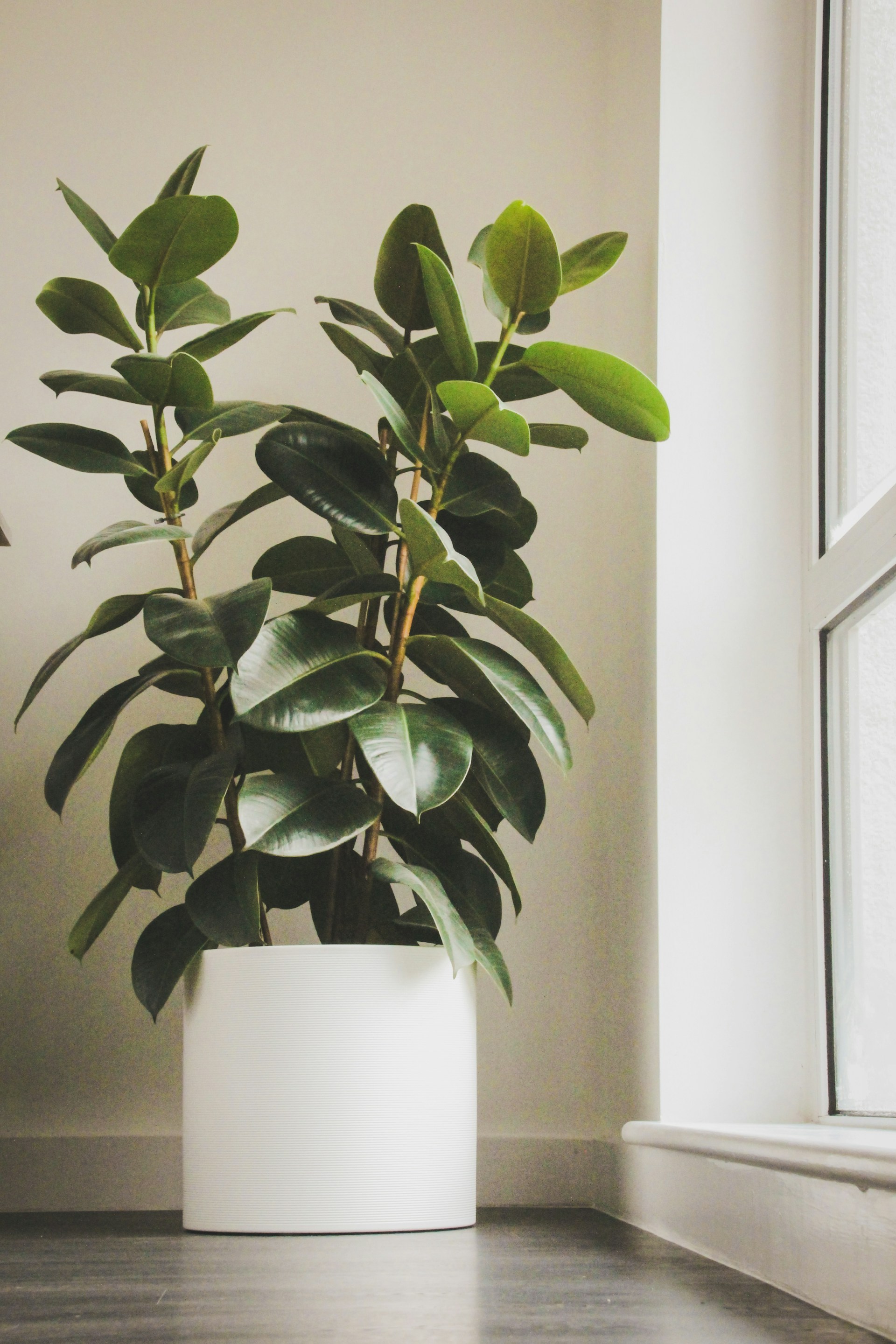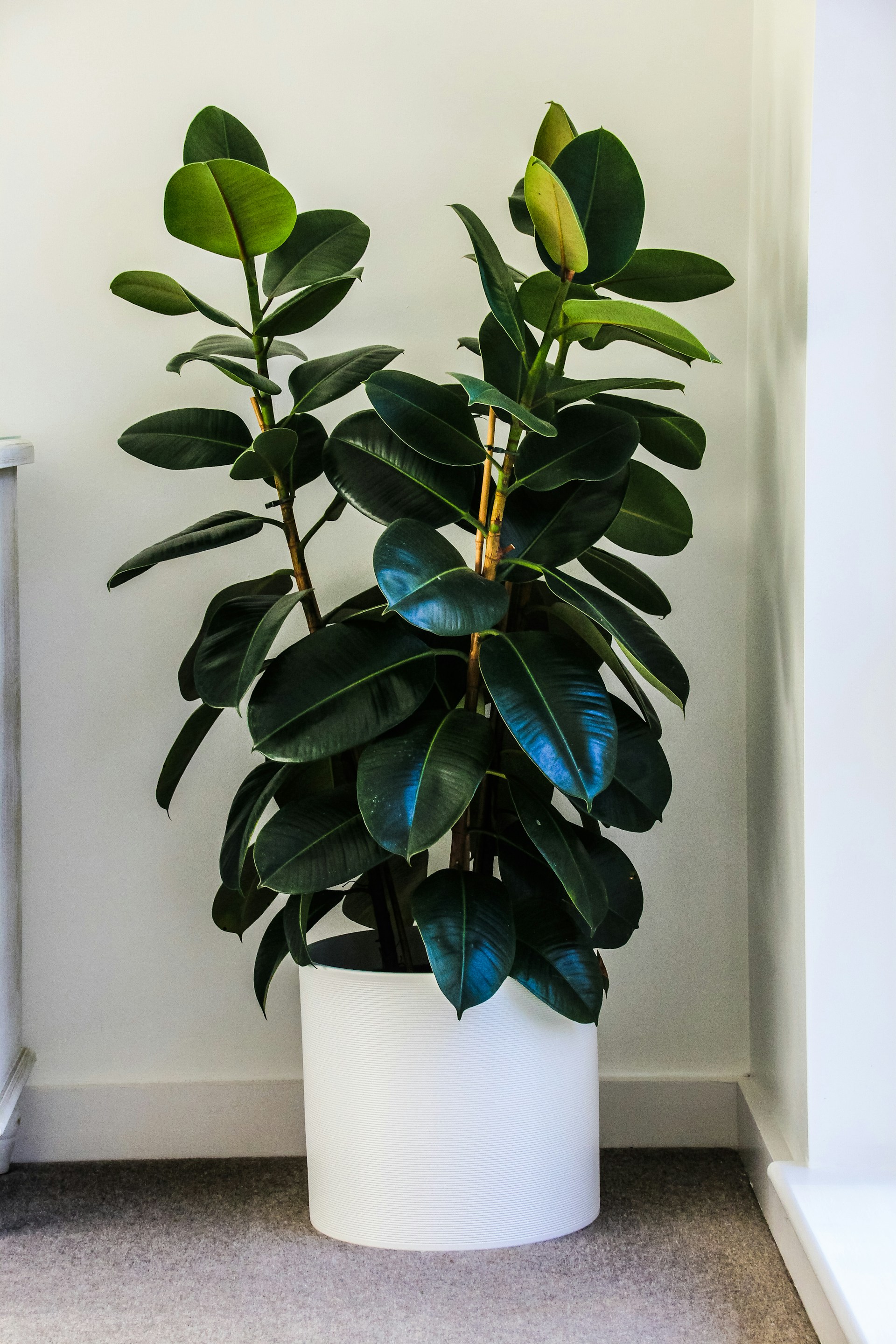Introduction to Rubber Plant: A Stunning Indoor Essential
The rubber plant (Ficus elastica) is a beloved choice among indoor plant enthusiasts. With its broad, glossy leaves and upright growth habit, this resilient beauty adds a touch of nature and elegance to any living space. Native to Southeast Asia, particularly India and Malaysia, it belongs to the fig family, Moraceae. While commonly known as “rubber plant”, it is also referred to as Indian rubber tree or simply Ficus elastica.

A Hardy Tropical Plant with Modern Charm
Despite its tropical origin, the rubber plant has earned its place in modern homes worldwide due to its adaptability and stylish appearance. Its thick, dark green leaves with a burgundy hue in some varieties make it not just a plant, but a decorative statement.
Rubber plants can reach 2 to 3 meters in height indoors if left unpruned, making them ideal for adding vertical greenery to a space. Outdoors in tropical regions, they may soar up to 30 meters in the wild.
Ideal Conditions and Climate Needs
Temperature and Humidity Preferences
Being a tropical plant, the rubber plant thrives best in warm, humid conditions. The ideal temperature range is 15 – 24°C, and it does not tolerate cold or frost. It prefers consistent temperatures and doesn’t respond well to sudden drafts or temperature fluctuations.
To support its natural needs, it’s advisable to mist the plant occasionally or use a humidifier during dry months.
-
All Products
Plant Care Humidifier – Ultrasonic, Mute, Intelligent with Remote Control and Aromatherapy
£138.40 Select options This product has multiple variants. The options may be chosen on the product page -
All Products
Flame Effect Aromatherapy Humidifier – Ultrasonic Plant Care Device (250 ml)
£29.99 Select options This product has multiple variants. The options may be chosen on the product page -
All Products
Ultrasonic Aroma Diffuser with Colorful Night Light – Silent Essential Oil Diffuser with Remote Control
£76.50 – £83.61 Select options This product has multiple variants. The options may be chosen on the product page -
All Products
Portable Humidifier for Plants – Keep Your Greenery Healthy Anywhere
£28.87 Select options This product has multiple variants. The options may be chosen on the product page
Lighting Requirements
Rubber plants grow best in bright, indirect light. A spot near a window with filtered sunlight is ideal. Direct sunlight may scorch its leaves, while too little light can lead to leggy growth.

Watering and Soil Guidelines
Watering the rubber plant requires balance. Overwatering can lead to root rot, while underwatering causes drooping leaves. The top inch of the soil should dry out between waterings. Reduce watering frequency in winter months.
A well-draining potting mix is essential—a mix of peat, pine bark, and perlite works well to ensure proper drainage and aeration.
Growth Rate and Maintenance Tips
Growth Characteristics
Rubber plants grow steadily and can develop into large, tree-like structures indoors. With proper care, you may notice 10–15 cm of new growth per month during the warmer seasons.
Pruning and Shaping
To keep the plant compact and bushy, pruning is encouraged. Prune during spring or early summer, and always use sterilized shears. Pruning also encourages side branching.
-
All Products
Stainless Steel Pruning Shears – Multifunctional Elbow Design for Efficient Branch Cutting
£19.99 – £29.99 Select options This product has multiple variants. The options may be chosen on the product page -
All Products
Pruning Shears – Branch Cutting Tools for Gardening, Household & Fruit Tree Maintenance
£31.99 – £35.99 Select options This product has multiple variants. The options may be chosen on the product page -
All Products
Pruning Shears for Gardening – Heavy-Duty Manganese Steel Branch Cutter with Safety Lock
£22.99 Select options This product has multiple variants. The options may be chosen on the product page
Rubber Plant Varieties
Plants come in several varieties, each with its unique charm:
- Ficus elastica ‘Robusta’: Known for its deep green, thick leaves.
- Ficus elastica ‘Tineke’: Features stunning variegated foliage with cream and green shades.
- Ficus elastica ‘Ruby’: Offers reddish-pink hues in its foliage.
These variations allow plant lovers to find a rubber plant that fits their style and space perfectly.
Air Purifying Qualities and Benefits
Rubber plants are not just attractive—they’re functional too. According to NASA’s Clean Air Study (1989), rubber plants are effective at removing formaldehyde and other toxins from indoor air. This makes them a smart and stylish choice for improving your home’s air quality.
[NASA Clean Air Study – https://ntrs.nasa.gov]

Common Issues and How to Handle Them
Despite being low maintenance, rubber plants may face a few challenges:
- Yellowing Leaves: Usually due to overwatering.
- Brown Tips: Often caused by low humidity.
- Leaf Drop: Could be due to sudden temperature changes or relocation stress.
The key to avoiding most issues lies in consistent care and observation.
Propagation: Multiply the Beauty
Rubber plants can be propagated through stem cuttings. Here’s a simple method:
- Cut a healthy stem with a few leaves.
- Let it dry for a few hours to allow sap to seal.
- Plant the cutting in moist soil or place in water.
- Keep it in a warm, bright spot until roots develop.
This method allows you to expand your plant collection or gift a new plant to a friend.
FAQ – Frequently Asked Questions
How often should I water my rubber plant?
Water it when the top inch of soil feels dry—typically once a week in summer and less frequently in winter.
Is rubber plant toxic to pets?
Yes, the plant’s sap can be mildly toxic if ingested by pets. Keep it out of reach of curious cats or dogs.
Can rubber plants grow in low light?
While they tolerate low light, growth may slow. For optimal health, place them in bright, indirect light.
Why are my rubber plant’s leaves curling?
Curling often indicates underwatering or low humidity. Check the soil moisture and mist the leaves.
Conclusion – Why Rubber Plant is Worth It
In conclusion, the rubber plant is more than just a pretty face—it’s a durable, air-purifying, and low-maintenance companion. With its lush foliage, minimal care demands, and modern vibe, it’s perfect for plant lovers at any level, especially for beginner plant parents looking to bring some green into their homes. It’s a plant that doesn’t just survive—it thrives with you.
Read More:
Rubber Plant Care Guide – Everything you need to keep your Rubber Plant healthy and thriving.
How to Grow Rubber Plant at Home – A step-by-step guide to successfully grow Rubber Plant indoors.
Plant Profile

Common Name

Plant Type

Mature Size

Sun Exposure

Soil Type

Soil pH

Bloom Time

Color

Hardiness Zones

Native Area

Humidity

Lighting

Temperature

Difficulty

Hibernation

Toxicity

Invasive
Rubber Plant
Houseplant
6 – 10 feet
Bright, Indirect light
Well-drained
6.0 – 7.0
Year round
Green
10 – 12
Southeast Asia
Moderate
Indirect sunlight
18°C – 24°C
Easy
No
Mildy Toxic
No















